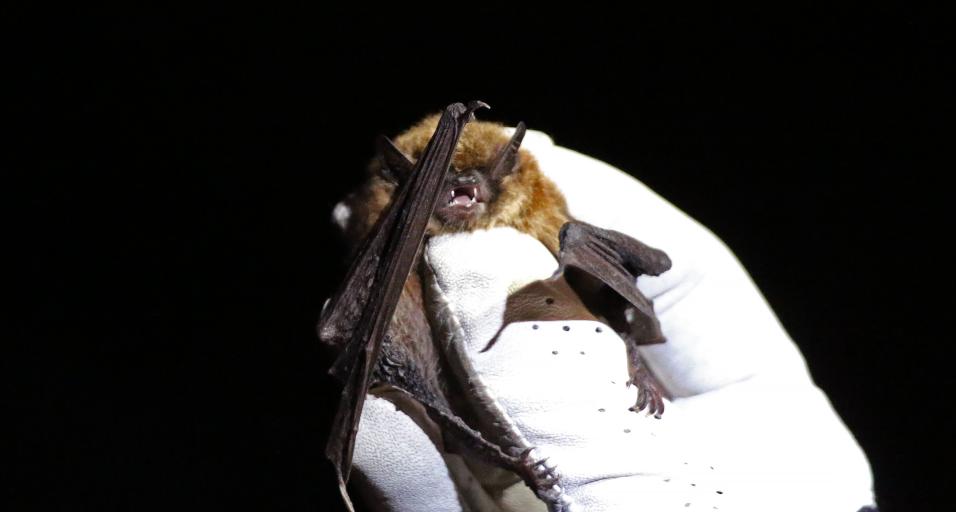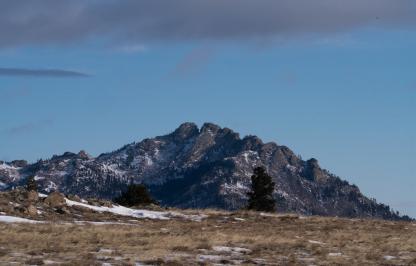The Wyoming Game and Fish Department is encouraging cavers, climbers and other explorers to clean shoes and gear before and after visiting caves. Pseudogymnoascus destructans (Pd) — the fungus that causes white-nose syndrome in bats — was newly identified in Carbon and Platte counties within caves that serve as hibernaculum for bats. Cleaning gear is essential to help bats and prevent the unintentional spread of white-nose syndrome in the state.
The U.S. Geological Survey — National Wildlife Health Center confirmed four bat species tested positive for Pd: Townsend’s big-eared bat, Western small-footed myotis, little brown myotis and western long-eared myotis. Researchers swab bats annually for the fungus in known hibernaculum — locations where bats spend the winter. It is the first time Pd has been identified in a hibernacula in Wyoming.
White-nose syndrome erodes the skin of hibernating bats and causes them to wake up more often than normal, which takes valuable energy. The syndrome kills bats through starvation or exposure when they leave the hibernaculum in search of food in the winter. It has been found throughout the eastern United States and Canada, as well as in the midwest, including South Dakota, Nebraska and Kansas. The fungus and white-nose syndrome do not impact humans or pets.
“It’s another disappointing — but not surprising — discovery for Wyoming’s bats. We know white-nose syndrome is moving to the west and additional spread within the state is likely,” said Zack Walker, Game and Fish non-game supervisor. “The disease has killed millions of bats across the continent and could have significant impacts on local populations. Bats are an important species because they are an incredible predator of insects.”
The caves where Pd was found are situated in the Shirley Mountains on Bureau of Land Management land in Carbon County, and in Platte County on Wyoming Military Department land. A nearby mine in Platte County was swabbed and tested negative for Pd. The Shirley Mountain site is Wyoming’s largest known hibernacula with around 75 bats of five different species wintering there and is a popular recreation destination. The cave has a seasonal closure during the coldest months of the year to limit disturbance to hibernating bats.
“Wyoming’s bat hibernacula are small, which may help slow bat-to-bat transmission of Pd and white-nose syndrome,” said Laura Beard, Game and Fish bat biologist.
With nearby site testing negative, bat biologists consider the situation on the ground a “mixed status” — which puts more emphasis on the human role in preventing the spread of the fungus and white-nose syndrome themselves between caves and other locations where bats winter and roost.
“Decontamination is critical right now. Please take care to clean gear and footwear — and don’t wear the same clothing between caves,” Beard said.
Wildlife researchers have previously confirmed the presence of white-nose syndrome in bats at Devils Tower National Monument in 2021 and detected Pd in southeast Wyoming in 2018.
“Past experiences show that when the fungus is detected it takes approximately two years for the beginning of population loss from white-nose syndrome. We’ll continue to monitor this location and other hibernaculum closely,” Walker said.
Game and Fish is now implementing a plan for responding to the detection of Pd. The department’s Strategic Plan for White-Nose Syndrome calls for increased coordination on management and prevention of the spread of white-nose syndrome and the Pd fungus. Action steps include limiting access to roost sites to prevent cross-contamination, putting in place further decontamination measures for those surveying bat species for scientific information and broadening surveys of roosts in an effort to monitor the spread of the fungus.
Game and Fish has been surveying bat populations for years. As part of routine monitoring, the department has been sampling known hibernacula for Pd. The state is home to 18 species of bats, representing a substantial contribution to our wildlife diversity.
Game and Fish will be working with the Bureau of Land Management and Wyoming Military Department, as well as the University of Wyoming — Bernard Lab on continued monitoring and response efforts to new Pd detections.
The agencies several requests for the public to help protect bats include:
- Clean your shoes and gear before and after you visit caves or other locations where bats are present to prevent the spread of the fungus to new areas.
- Don’t take gear or clothing that’s been in an area affected by white-nose syndrome to places that are free of the fungus.
- Check canopies, umbrellas and other items for bats before packing up. They could be home to a roosting bat and this prevents unintended movement of potentially infected bats to new areas.
- Report sick or dead bats during the winter/spring to the Game and Fish non-game section by calling (307) 332-2688. Try to record the location.
- Stay out of closed caves and mines.



